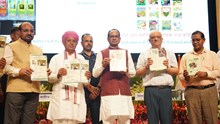
Many of you may not know about Purslane, which is scientifically known as Portulaca oleracea. This is a weed, so people may not pay much attention to it. However, this is one of the most nutritious foods in the world! Yes, it’s true. Also called little hogweed, duckweed, pusley, fatweed, and pigweed, this weed or let’s call it a leafy green is called “luni-bhaji” in North India and “kulfa” in other states of India.
Purslane is a weed that spreads quickly. It is a native of India. This cannabis is frequently available for purchase on Mumbai's streets.
Purslane is a tangle of crazily interwoven dark green leaves and reddish stalks that you might have seen at a vegetable stand. Gardeners, on the other hand, are irritated by this weed. The plant is hardy because to its thick, succulent leaves. Huge amounts of water are stored in the leaves. As a result, the plant is heat tolerant. This weed is also tough to eradicate.
India’s Gift to the World
Purslane weed has been identified as a native of India in several botanical investigations. This plant is well-known over the world, and a few authors have even referenced it in their works. Euell Gibbons, an expert on wild edibles and an American writer, has dubbed this herb "India's Gift to the World."
Regrettably, the Indians have nearly completely forgotten about this gift. Purslane is used by a minority of people. You can rarely see it in the market. This is due to the fact that just a few people are aware of its nutritional significance. Many people are unaware that this herb may be eaten.
Purslane is hardly cultivated. It grows wildly in various places. Many people don’t even recognize this weed or plant.
Mahatma Gandhi ate this weed
Mahatma Gandhi was one person who knew the value of this weed. Many food writers in foreign land have mentioned that it was one of the favorite foods of Gandhi. Well, we do not whether this is true, but one this is certain: he did recommend eating purslane.
In one of his articles in the magazine Harijan he wrote, “the nourishing properties of the innumerable leaves that are to be found hidden among the grasses that grow wild in India."
Gandhiji had discovered this weed when he was staying in Wardha and following a diet of raw foods. According to records, Gandhiji was happy to see this weed in the hands of an ashram resident.
As per an excerpt from this article, “brought to me a leaf that was growing wild among the ashram grasses. It was luni. I tried it, and it agreed with me.” Soon, luni became an integral part of Mahatma Gandhi’s diet.
Nutrition value of purslane
Purslane is loaded with Vitamins A, B, and C, folate, pyridoxine, riboflavin, and niacin. The weed is rich in minerals like calcium, magnesium, and iron, plus caratenoids. It also has lots of two betalain alkaloid pigments, which are potent antioxidants.
How to use purslane?
You can include purslane in your diet as one of the ingredients of your salad that contains lettuce leaves, tomatoes, cucumber, and olives. Or you can also make “saag,” or cook it like a sabzi.
About 100 grams of purslane contains only 16 calories, but loads of dietary fiber. It is rich in omega 3 fatty acids. These are great for heart health and brain power.
















